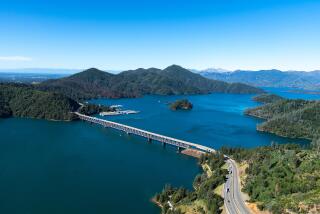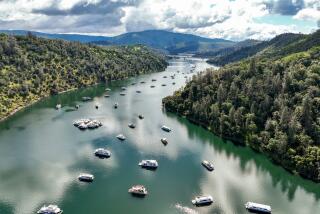Rising Above It All : Green Valley Lake Offers Civilized Outdoor Experience Thanks in Part to the “Admiral”
GREEN VALLEY LAKE — Jim Allison interrupts himself in mid-sentence to exclaim, “Oh, my gosh, we’ve got a swimmer in the lake!”
He picks up a megaphone and aims it across the lake. “Sorry, no swimming in that part of the lake,” he barks.
The swimmer meekly leaves the water. Allison runs a tight ship, which might be why the locals nicknamed him “Admiral” when he took over the rental-boat concession in 1977.
Allison’s domain lies before him: a tiny jewel of an alpine lake set in a pine forest, where the standards are trophy-size trout and a civilized outdoor experience.
“There’s no trash, no graffiti, no swearing, no loud radios, no rowdy behavior,” Allison says, “and if anyone doesn’t like the rules, we tell ‘em how to get to Big Bear.”
The Admiral’s code of conduct is meant to make fishing at Green Valley Lake a pleasant experience. On the lake there are no conflicts among fishermen, water skiers and jet skiers because no motors are allowed. Nobody seems in a hurry. Even when you troll, you row. Noise and other annoyances are left in the city.
At 6,800 feet, Green Valley Lake is above all that, situated four miles off California 18, which reaches Big Bear Lake 17 miles farther along in the San Bernardino Mountains. There’s home cooking at a couple of small restaurants and a large U.S. Forest Service campground a mile past the lake, but the nearest motels are in Running Springs--although about half of the several hundred private cabins hidden back from the lake seem to be for rent or for sale.
There are only about 300 year-round residents. Most visitors come for the fishing, which Allison has enhanced the last three years by augmenting California Department of Fish and Game plants with stocks of larger trout from a private hatchery. The lake record is 13.52 pounds, caught on July 8 by Tom Herrera of San Fernando, using green Power Bait.
Aside from fishing, the highlight of the year is coming up this Labor Day weekend: the three-day, 56th annual Water Carnival, featuring “fun for the whole family,” according to a flier. Activities will include a volleyball tournament and rowboat, paddleboard, sailboat and swimming races--the latter all the way from the dam to the swim raft near the opposite end . . . about 300 yards. Green Valley Lake isn’t very big.
*
That’s part of the beauty of it. In the crisp, still mountain air, you can carry on a conversation with someone on the other side. Shore fishermen cast halfway across in places.
Allison, who is single, moved to the lake in 1976 from Inglewood, where he worked at a treatment center for emotionally disturbed children, seven days on and seven days off.
“I loved the mountains,” he says. “I came here looking for a place (to live), figuringI could live here on my weeks off.”
Soon he heard that the lake concession was for sale and he bought it, with the approval of the 1,500 shareholders of the Green Valley Mutual Water Co. The dam was built in 1928 to create the lake solely for recreation. No water is taken for irrigation or domestic use, and most of the loss by evaporation is replenished by springs on the bottom, so the water level normally doesn’t vary more than a couple of feet.
“During the drought, it was low, but this is such a small lake that the runoff from about a three-foot snowfall in the winter will darn near fill it,” Allison says.
Green Valley Lake’s surface covers 10 acres. Jerry Eaker figures it’s about a mile around. He knows because he walks it three or four times a day collecting daily fishing fees from shore anglers: $4 each, $2 for those younger than 16.
Not only the lake but life at Green Valley is so compact that sometimes it feels like a sitcom. Eaker--tall, lanky, amiable and earnest--could be George Utley, Bob Newhart’s handyman at the Stratford Inn, ambling along the shore with his change apron, greeting anglers and stamping wrists with the color of the day.
“Jerry’s my right-hand man,” says Allison.
There is even a teen-age interest: local resident Susan Casner, 16, who followed an older sister into her summertime job renting boats.
Eaker came to Green Valley Lake in 1985 after 17 years as a civilian employee at the Long Beach Naval Shipyard, where he specialized in military electronics.
“It was a good job, but I was getting too sick,” Eaker says. “I think it was the exposure to the sidestream tobacco smoke. There was a lot of smoking in all of the buildings. So I left there, came up here, and have felt a lot better.”
Allison adds: “If we could get away with it, I would make this a no-smoking lake too.”
When Allison bought the operation, it consisted of a few rowboats and paddleboards. He replaced all the wooden boats with aluminum ones and added kayaks, canoes and pedal boats. Fishing was $1.
In 1991, Allison checked into the economics of a trout augmentation program. The fish cost slightly more than $2 a pound, but he thought it might work if the traffic would bear a fee hike to $4. The attraction of fish larger than the half-pounders provided by the DFG seems to work. Anglers line the shore daily.
Allison buys the oversize fish from the Whitewater hatchery near Palm Springs. At first, the problem was that the hatchery would deliver only a minimum of 1,000 pounds per trip--too many fish for the small lake to accommodate at one time. So Allison and Eaker built their own fish tank on a trailer, and every week or two, they hitch it to Allison’s pickup truck and go down the hill to get several hundred pounds of trout.
The fish run from two to three pounds, with a few 10 pounds or larger. Allison and Eaker seem to be able to distinguish them from the DFG planters.
“State stocker,” Eaker sniffs as an angler nets a pan-sized catch.
Allison’s permit from the DFG requires him to match the state plants, pound for pound, but he exceeded that last year, as he will this year, with perhaps 11,000 pounds. The DFG also demands a quality environment.
“You have to provide so many bathroom facilities, do a trash pickup, keep the roads graded and the parking areas in decent shape,” Allison says. “You have to keep the lake somewhat free of algae and weeds . . . keep the clarity there. The money that comes in from those (extra) fees helps to offset those costs.”
The anglers don’t complain about the $4 fee. Much.
Eaker says: “I get a fair number of people telling me, ‘Oh, I didn’t know that’--and most of ‘em really do. It’s posted all over the place.”
*
It’s not a perfect world, even at Green Valley Lake.
“That’s a big pain in the butt over there . . . the (swim) beach,” Allison said, nodding toward the upper end to his right. “A lot of parents just bring their kids down and dump ‘em out the door, and they’re the ones that give the lifeguards the biggest headaches.”
And yes, he also has to hire lifeguards.
“Making this place go is a heck of a lot of work,” Eaker says. “Jim works seven days a week during the season, and he’s working 10 or 12 hours a day.”
Eaker works six days. The season opens when the ice thaws, usually in April. After Labor Day and through the end of the season, it will usually be only Allison and Eaker staying on to take care of the hard-core anglers who pursue the big trout until, as Allison says, “the first snow flies. There’s so much labor cost in the summer that you have a better chance to make a buck after the beach closes and the kids go back to school.”
Last year, they stayed open until Dec. 5, when they had to close fishing only because the lake started to freeze.
As fall approaches, Allison says: “It’s been a wonderful 18 years,” but with the lack of free time and the aggravations that go with any business, he is thinking about selling out.
Anybody want to run a lake?
More to Read
Sign up for The Wild
We’ll help you find the best places to hike, bike and run, as well as the perfect silent spots for meditation and yoga.
You may occasionally receive promotional content from the Los Angeles Times.






